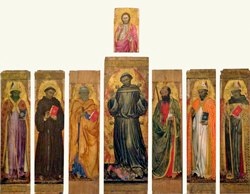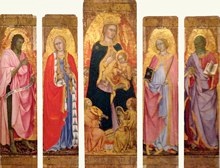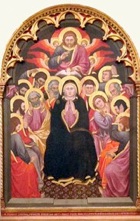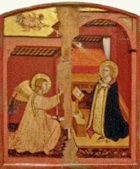Taddeo di Bartolo di Mino was born in Siena. Among his early documented works is a panel (1390) of the Madonna and Child enthroned in the chapel of San Paolo, Collegarli, near San Miniato al Tedesco, which is signed and dated by inscription. He worked mostly in Tuscany, although he also worked in Perugia in 1403 (see below).
Gubbio
St Clare (early 15th century)
This fragment, which is the upper part of a panel that probably came from a polyptych, was the subject of a bequest to the Museo Diocesano. It depicts the upper part of St Clare holding the pyx with which she repelled a Ghibelline attack on San Damiano, Assisi. It is attributed to Taddeo di Bartolo di Mino on the basis of comparison with the panels (1403) from San Francesco al Prato, Perugia that are now in the Galleria Nazionale (see below).
Perugia
Panels from a polyptych (1403)
This double-sided polyptych, which is signed by Taddeo di Bartolo and dated by inscription, was painted for the high altar of San Francesco al Prato. The “new” polyptych was probably dismantled in 1536, the date at which the altar was moved backwards into the apse and re-consecrated. The individual panels were moved to the sacristy and then, in 1810, to the Accademia di Belle Arti. The panels of SS Peter and Paul were taken to the Musei Capitolini, Rome in 1812 but returned to Perugia in 1817.
Modern scholarship has revealed that the polyptych originally comprised seven vertical planks, each of which was painted on both sides and each side of which had images in three registers. These planks were subsequently split into the 42 individual images.

The seven panels from the central register of the side that faced the retro-choir are all exhibited in the Galleria Nazionale. They depict:
-
✴St Francis in a mandorla borne by angels, displaying all five wounds of his stigmatisation and crushing Lust, Power and Greed (in the central panel);
-
✴SS Herculanus, Antony of Padua and Peter (on the left); and
-
✴SS Paul, Constantius and Louis of Toulouse (on the right).
The whereabouts of two other panels that probably came from this side of the polyptych are known:
-
✴The panel from the centre of the upper register that depicts Christ displaying his wounds found its way to the gallery separately from the others.
-
✴A small panel in the Musée du Louvre, Paris that depicts of the Crucifixion with St Francis at the foot of the cross, possibly came from the central part of the predella.
The placing of these two panels respectively above and below the central panel of St Francis displaying his wounds constitutes one of the earliest depictions of him as "alter Christus" (the second Christ).

The inner five of the seven panels from the main register of the side that faced the congregation are also exhibited in the gallery. They depict:
-
✴the Madonna and Child with musical angels (in the central panel);
-
✴SS John the Baptist and Mary Magdalene (on the left); and
-
✴SS Catherine of Alexandria and John the Evangelist (on the right).
Two other panels from this side also survive:
-
✴The figure of St Elizabeth of Hungary, which came from the extreme right of the main register, is now in the Perkins collection in the Museo del Tesoro di San Francesco, Assisi.
-
✴The figure of Christ blessing, which came from the upper register of the central panel, is now in the Yale University Art Gallery, New Haven, Connecticut.
Six small panels of scenes from the life of St Francis in the Niedersächsischen Landesgallerie, Hannover and a seventh in the Van Heek Collection, Heerenberg, Holland came from the predella.
Pentecost (1403)

The upper part of the panel depicts God the Father sending the Holy Spirit in the form of a dove to the Virgin and Apostles assembled below.
Annunciation (ca. 1410)




